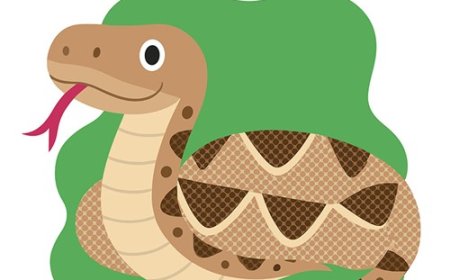Burmese Python Facts for Kids – Giant Constrictor Snake
Learn about the Burmese python, one of the world’s largest snakes, found in Asia and invasive in Florida
Burmese Python Facts for Kids – Giant Constrictor Snake
Scientific Name and Classification
- Common Name: Burmese python
- Scientific Name: Python bivittatus
- Kingdom: Animalia
- Phylum: Chordata
- Class: Reptilia
- Order: Squamata
- Family: Pythonidae
- Genus: Python
- Species: P. bivittatus
🐍 Introduction
The Burmese python is one of the largest snakes on Earth. It is a powerful constrictor. It lives in Southeast Asia and is invasive in Florida, USA. It is known for dark brown blotches on a tan body. It moves quietly and ambushes prey.
🦎 Appearance
Adults often reach 10–16 ft (3–5 m). Some grow over 18 ft (5.5 m). Very large snakes can weigh more than 200 lb (90 kg). The head is wedge-shaped. The pattern shows bold brown patches with light borders. The belly is pale. Heat-sensing pits line the upper lip.
🌍 Habitat
Native range: India’s northeast, Myanmar, Thailand, Laos, Cambodia, Vietnam, southern China, and Indonesia. It uses forests, grasslands, marshes, and farmland edges. It stays near water and is a strong swimmer. In Florida, it thrives in Everglades wetlands.
🍽 Diet
The Burmese python is a carnivore. It eats birds, rodents, pigs, deer, and other small to medium mammals. It is an ambush hunter. It strikes, coils, and constricts until the prey cannot breathe. It swallows prey whole.
🔄 Life Cycle
Breeding happens in the cooler season. Females lay 20–80 eggs (sometimes more). The mother coils around the clutch. She warms the eggs by “shivering” her muscles. Hatching occurs after ~60–90 days. Young snakes are independent at birth. Wild lifespan can exceed 20 years.
🐾 Behavior and Social Structure
The Burmese python is solitary. It is mostly crepuscular and nocturnal. It basks by day when cool. It uses smell and heat pits to find prey. It is calm when not threatened but very strong.
🛡 Conservation Status
IUCN Red List: Vulnerable.
Main Threats: Habitat loss, hunting for skin and meat, and pet trade collection.
Protections: Trade controls, protected areas, education on responsible pet ownership.
🎭 Cultural Significance
In parts of Southeast Asia, the species appears in markets for meat and skins. It also appears in festivals and stories. In the U.S., it is a focus of conservation and invasive-species education.
✨ Fun Facts
- Among the world’s largest snakes.
- Excellent swimmer; can stay underwater for 30 minutes.
- Moms warm eggs with muscle shivers.
- Can go weeks or months between big meals.
- Has heat-sensing pits to detect warm-blooded prey.
📌 Key Takeaways
- Giant constrictor native to Southeast Asia.
- Ambush hunter that eats mammals and birds.
- Females lay large clutches and guard them.
- Vulnerable in native range; invasive in Florida.
- Strong swimmer and powerful constrictor.
- Lives in wetlands, forests, and farmlands.
🐾 Kid-Friendly Summary
The Burmese python is a huge snake. It sneaks up on prey and squeezes it. Moms guard their eggs. In Asia it needs protection. In Florida it causes problems for native animals.
📚 Vocabulary Words
- Constrictor – A snake that squeezes prey to stop breathing.
- Ambush – A surprise attack after hiding and waiting.
- Crepuscular – Most active at dawn and dusk.
- Invasive – A species that spreads in a new place and harms local life.
- Clutch – A group of eggs laid at one time.
- Incubation – Time while eggs develop before hatching.
- Heat-sensing pits – Small openings that detect body warmth.
- Wetland – Land with water on or near the surface.
- Camouflage – Colors and patterns that help an animal hide.
- Nocturnal – Active at night.
🧠 Interactive Quiz: Test Your Burmese Python Knowledge
- What type of hunter is a Burmese python?
- A. Chase hunter
- B. Ambush hunter
- C. Filter feeder
- D. Grazing feeder
- What does a Burmese python mainly use to kill prey?
- A. Venom
- B. Constriction
- C. Claws
- D. Webs
- Where is the Burmese python invasive in the United States?
- A. Rocky Mountains
- B. Everglades of Florida
- C. Great Plains
- D. Pacific Northwest
- How does the mother keep her eggs warm?
- A. Sunbathing on them
- B. Using body heat from shivering muscles
- C. Building a fire
- D. Letting the male guard them
- True or False: Burmese pythons are poor swimmers.
- True
- False


















































